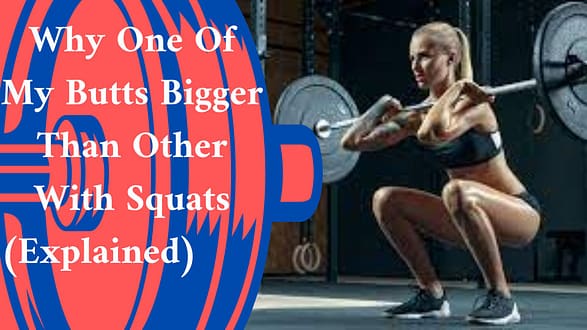Are you puzzled about why one of your buttocks is larger than the other after doing squats? Dive into this article to discover the reasons behind the imbalance and how to address it.
It is common for one buttock to be larger than the other, and this can be exacerbated by squats if proper form is not maintained. If you favor one leg over the other during squats or have poor posture, it can lead to uneven stress distribution on the buttocks. Additionally, muscle imbalances or anatomical differences can also contribute to asymmetry. To address this, try incorporating unilateral exercises such as lunges and single-leg squats to even out muscle development, and focus on maintaining proper form during squats to distribute stress evenly.
Let me tell you, when you favor one leg over the other during squats, or your posture is all over the place, you’re putting uneven stress on your glutes.
And guess what? That can lead to muscle imbalances and even injuries down the road.
I mean, come on! Do you really want to end up with a lopsided booty? Not only does it look weird, but it can cause lower back pain, hip problems, and even knee issues.
And don’t even get me started on the embarrassment of having to explain to people why your butt looks like it’s been through a war.
So, let’s get real for a moment. If you want a firm, round, and symmetrical butt, you need to pay attention to your form when you’re doing squats.
Keep your weight evenly distributed between both legs, and maintain good posture throughout the exercise.
And hey, if you’re not sure how to do squats correctly, don’t be ashamed to ask for help. There are plenty of trainers out there who can show you the right way to squat, and help you avoid the pitfalls of muscle imbalances.

Muscle imbalances or anatomical differences.
Muscle imbalances and anatomical differences that can lead to unevenness in our glutes. I know it can be frustrating to work hard on getting a symmetrical butt, only to be held back by factors outside of your control.
Listen, muscle imbalances are no joke. They can cause pain, discomfort, and even limit your range of motion. And do not forget about the emotional toll they can take on you.
It’s not easy to feel self-conscious about the way your bodies look, and it can really mess with your confidence.
And then there are anatomical differences. Sometimes, your bodies are just built differently, and that can lead to unevenness in our glutes. It’s not fair, but it’s a reality you have to deal with.
But here’s the thing, you can still work to improve the appearance and functionality of your butts, even if you have muscle imbalances or anatomical differences.
There are exercises and stretches that can help to strengthen weak muscles and improve flexibility.
And, if the unevenness is causing significant pain or discomfort, there are medical treatments available that can help. Don’t be afraid to talk to a doctor or physical therapist about your options.
DO Not beat yourselves up over things you can’t control. Instead, focus on what YOU can do to improve your bodies and confidence.
Distribute stress evenly
You need to incorporate unilateral exercises into our routine. That means lunges, step-ups, and single-leg squats.
These exercises are great because they work one leg at a time, allowing us to focus on building strength and muscle in each glute independently. That way, YOU can target any areas that are weaker and work on developing a symmetrical booty.
But let me tell you, it’s not just about the exercises you do. You need to make sure we’re maintaining proper form during squats too.
That means keeping our weight evenly distributed between both legs and avoiding any favoritism. you also need to pay attention to our posture and make sure we’re engaging our glutes throughout the exercise.
And hey, don’t be afraid to seek out guidance from a personal trainer or coach. They can help us identify areas of weakness and give us targeted exercises to address them.
They can also make sure you’re using proper form during squats and other exercises, reducing the risk of injury and ensuring you’re getting the most out of our workouts.
Do not let asymmetry get us down. You have the power to take action and build the booty you want. incorporate unilateral exercises and focus on maintaining proper form during squats.
With dedication and hard work, you can overcome muscle imbalances and build the symmetrical glutes of our dreams!
Round your butt-related video here
Final Thoughts
In conclusion, having uneven buttocks after squats is a common issue that can leave you feeling self-conscious and frustrated.
But the good news is that it’s fixable with the right exercises and training. By assessing muscle imbalance, correcting your posture, and working on your weak side, you can achieve a more symmetrical and toned butt. Don’t let asymmetry bring you down.
Keep working hard, and soon enough, you’ll be able to show off a booty that’s perfectly balanced and beautiful. Keep squatting!
Related Article:
Are Front Squats Better To Do Than Back Squats? (5 things to know- Explained)

Hey there, it’s Mike Rrsq, the Editor-in-Chief over at Jsquat.com, and I’m absolutely obsessed with all things squat fitness! I’ve been lucky enough to get some serious recognition for my work in this field. With a solid background in the fitness and wellness industry, I’ve been there right from the get-go, helping shape this website into what it is today.
You see, I’m not just the boss around here; I’m also a passionate contributor. I love sharing my insights through my articles, and trust me, they’re not your run-of-the-mill stuff. Each piece I write is a labor of love, filled with my expertise and real-world experience in the fitness universe. So, if you’re into fitness and looking for some inspiration, you’re in the right place!

